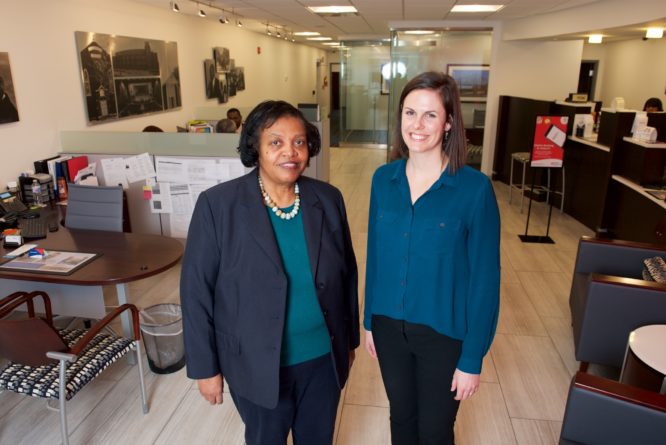Building Equity through Enhanced Access to Banking
The expert testimony, research, scholarship, and lived experience collected by the Commission revealed the following:
- As stated by researcher Martha Beard of the Federal Reserve Bank of St. Louis: “The word unbanked is an umbrella term used to describe diverse groups of individuals who do not use banks or credit unions for their financial transactions. They have neither a checking nor savings account… Underbanked consumers have either a checking or savings account, but also rely on alternative financial services” (Federal Reserve Bank of St. Louis, 2010).
- In 2013, nearly 30 percent of Missouri households were un- or underbanked, and a disproportionate number of them were Black (Federal Deposit Insurance Corporation, 2014).
- When people do not feel comfortable with or have convenient access to or knowledge of mainstream, traditional banking options, they often turn to alternative financial services (e.g., check cashers, payday lenders, pay cards, etc.) that are expensive and that provide scant means for savings that leads to wealth (U.S. Department of Treasury, 2011). As noted by the Federal Reserve Bank of St. Louis, “unbanked consumers spend approximately 2.5 to 3 percent of a government benefits check and between 4 percent and 5 percent of payroll check just to cash them. Additional dollars are spent to purchase money orders to pay routine monthly expenses. When you consider the cost for cashing a bi-weekly payroll check and buying about six money orders each month, a household with a net income of $20,000 may pay as much as $1,200 annually for alternative service fees—substantially more than the expense of a monthly checking account fee” (Federal Reserve Bank of St. Louis, 2010).
- Un- and underbanked individuals also miss out on valuable educational resources to build financial literacy, including important tools, products, services, and delivery channels that are critical to establishing a foundation for wealth accumulation and to reducing poverty (U.S. Department of Treasury, 2011). This gap in knowledge and relevant tools makes it harder for un- and underbanked individuals to build wealth.
- There are limited banking facilities in distressed communities. Limited access to banks, coupled with distrust of and unfamiliarity with the traditional banking system, leads many in such communities to be unbanked or underbanked (Federal Reserve Bank of St. Louis, 2010). A New York Times investigation of bank branch closures found that a disproportionate number of closures take place in low-income communities: “In low-income areas, where the median household income was below $25,000, and in moderate-income areas, where the median household income was between $25,000 and $50,000, the number of branches declined by 396 between 2008 and 2010. In neighborhoods where household income was above $100,000, by contrast, 82 branches were added during the same period” (Schwartz, 2011). Accordingly, many low-income individuals are unbanked because they lack access to banking facilities.
- The Community Reinvestment Act (CRA) is a federal law designed to encourage financial institutions to meet the needs of borrowers in all segments of their community, including low and moderate income neighborhoods (Board of Governors of the Federal Reserve System, 2014). The CRA mandates evaluations of depository institutions through a lending test, investment test, and service test. As these tests currently stand, however, compliance ratings are structured and managed subjectively by officials (Quercia et al., 2014). More than 98 percent of banks and thrifts receive passing “Satisfactory” or “Outstanding” ratings, but their quality of outreach and disclosure, risk-tolerance to investment, and quality of delivery channels are not guaranteed (Quercia et al., 2014).
- Community development financial institutions (CDFIs) are private financial institutions with the mission of “responsible, affordable lending to help low-income, low-wealth, and other disadvantaged people and communities join the economic mainstream” (Opportunity Finance Network). CDFIs tend to serve those who need greater levels of risk-tolerance than most banks are willing to accept. In order to operate effectively, however, CDFIs rely heavily on adequate funding that allows CDFIs to remove barriers keeping many low-income individuals from engaging with the traditional banking structure (e.g., inconvenience, lack of knowledge, high credit check standards when opening accounts, high minimum balance requirements, etc.) (Pinsky, 2001).
These findings prompted the Commission to draft several calls to action that build equity through enhanced access to banking, especially for low-income individuals and families.
To that end, the Commission issues the calls to action found below.
Take Action
Support increased access to care
Contact your local state legislator to express your support for Medicaid expansion. Join local or state advocacy organizations to get involved.
Invest in a child’s future
Make a financial investment in a child’s savings account.
Suggested Reading List
Schwartz, N. (2011). Bank closings tilt toward poor areas. New York Times. Retrieved from: https://www.nytimes.com/2011/02/23/business/23banks.html
Citations
- Beard, M. (2010). In-Depth: Reaching the unbanked and underbanked. Federal Reserve Bank of St. Louis Retrieved from: https://www.stlouisfed.org/Publications/Central-Banker/Winter-2010/Reaching-the-Unbanked-and-Underbanked
- Board of Governors of the Federal Reserve System. (2014). Community Reinvestment Act – About. Retrieved fromhttps://www.federalreserve.gov/communitydev/cra_about.htm
- Federal Deposit Insurance Corporation. (2009). National Survey of Unbanked and Underbanked Households. Retrieved from:https://www.fdic.gov/householdsurvey/2009/full_report.pdf
- Federal Deposit Insurance Corporation. (2014). National survey of unbanked and underbanked households-appendices. Retrieved from:https://www.fdic.gov/householdsurvey/2013appendix.pdf
- Hardman, D. (2015). Report to General Assembly pursuant to section 408.506, RSmo. Retrieved from:https://finance.mo.gov/Contribute%20Documents/2015PaydayLenderSurveyReport.pdf
- Opportunity Finance Network. What is a CDFI? Retrieved from: https://ofn.org/what-cdfi
- Pinsky, M. (2001). Taking Stock: CDFIs Look Ahead After 25 Years of Community Development Finance. Brookings Institution. Retrieved from:https://www.brookings.edu/research/articles/2001/12/metropolitanpolicy-pinsky
- Quercia, R., Ratcliffe, J., and Stegman, M. (2014). The Community Reinvestment Act: Outstanding, and Needs to Improve. Federal Reserve Bank of San Francisco. Retrieved from: https://www.frbsf.org/community-development/files/cra_outstanding_needs_improve1.pdf
- Schwartz, N. (2011). Bank closings tilt toward poor areas. New York Times. Retrieved from:https://www.nytimes.com/2011/02/23/business/23banks.html
- Thomas, K. (2000) CRA Grade Inflation. Levy Institute Working Paper No. 313. Retrieved from: https://papers.ssrn.com/sol3/papers.cfm?abstract_id=246827
- US Department of Treasury. (2011). Banking on Opportunity: A Scan of the Evolving Field of Banks on Initiatives. Retrieved from:https://www.treasury.gov/resource-center/financial-education/documents/banking%20on%20opportunity%20nov%2011.pdf


